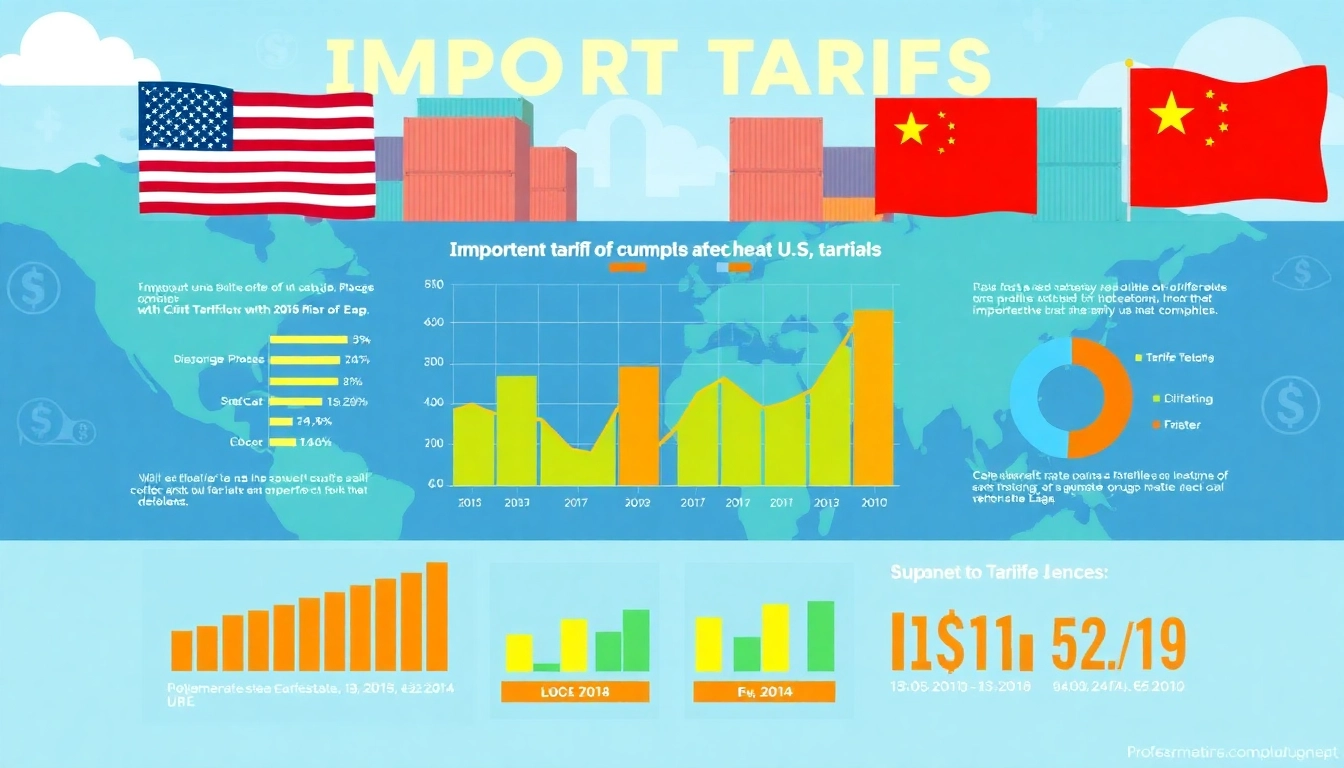
What Are Import Tariffs China and Their Purpose?
Definition of Import Tariffs
Import tariffs are taxes imposed by a government on goods brought into the country from foreign nations. Specifically, in the context of import tariffs China, these tariffs are levied on products imported to the United States from China. They serve multiple purposes, including protecting domestic industries from foreign competition, raising government revenue, and influencing trade balances. By increasing the costs of imported goods, tariffs can encourage consumers to buy domestic products, thereby supporting local businesses and employment.
Historical Context of U.S.-China Tariffs
The U.S. and China have had a tumultuous trade relationship characterized by fluctuations in tariff rates. Historically, tariffs on Chinese imports were relatively low until the onset of trade tensions in the late 2010s. The trade war initiated by former President Donald Trump aimed to address perceived unfair trade practices by China, leading to significant increases in tariffs on a wide range of goods. At one point, tariffs reached as high as 25% on many categories of products. Understanding the evolution of these tariffs is crucial to grasp their current implications for trade relations.
In 2020 and 2021, the landscape shifted again as some tariffs were reduced under ongoing negotiations, although significant tariffs remained in effect. As of 2025, the dynamic nature of these tariffs continues to influence not only bilateral trade but also global supply chains, impacting prices and availability of goods.
How Tariffs Affect Trade Balance
Tariffs profoundly impact a country’s trade balance, which is the difference between the value of exports and imports. When tariffs are applied to imports, they can decrease demand for foreign goods, theoretically growing the domestic market. For example, if U.S. tariffs create a substantial price increase on Chinese electronics, consumers may turn instead to American-made alternatives, enhancing local sales. However, while tariffs can improve short-term trade balances, they may also lead to retaliatory measures from other countries, further complicating economic relationships.
Current Import Tariffs China Rates
Overview of Current Tariff Rates
As of mid-2025, the U.S. has implemented a tiered tariff structure on imports from China. Recent agreements have established a baseline reciprocal tariff of 10% on most goods, but additional tariffs based on specific categories have pushed rates up significantly. For instance, products associated with the fentanyl trade have a 20% tariff, while many consumer goods have maintained rates between 25% and 30%. The most alarming are claims that the total tariff can reach as high as 55% in certain contexts for specific items.
Recent Changes in Tariff Policies
Recent political shifts have seen attempts to renegotiate existing tariffs. In June 2025, President Trump announced that the tariffs imposed on Chinese imports would not only remain high but could potentially rise, showcasing a volatile environment for businesses reliant on Chinese products. The complexity surrounding these tariffs means American businesses need to stay informed about both existing and emerging policies to navigate their trade strategies effectively.
Factors Influencing Tariff Rates
Several factors affect tariff rates, including political relationships, economic conditions, and changes in trade legislation. Economic theories suggest that volatility in tariffs can arise from geopolitical tensions, such as military conflicts or diplomatic debates over other human rights or climate issues. Additionally, domestic economic conditions influence tariffs; for instance, a downturn in the U.S. economy may lead to increased protectionist measures to protect local jobs.
The Impact of Import Tariffs on U.S. Businesses
Challenges Faced by American Importers
U.S. businesses that import goods from China face a multitude of challenges arising from high tariffs. One of the most pressing issues is increased costs that reduce profit margins. For industries reliant on low-cost raw materials, the additional financial burden can be significant. Companies in the electronics, textiles, and manufacturing sectors often struggle with fluctuating prices and supply chain disruptions, forcing some to consider alternative sourcing strategies.
Strategies for Managing Tariff Costs
To mitigate the financial implications of tariffs, businesses can adopt various strategies. Diversifying suppliers by sourcing materials from countries with lower or no tariffs can be a solution. Additionally, companies may look into tariff classification errors that could allow them to pay lower rates. Engaging in trade agreements or utilizing foreign trade zones can also create cost-saving opportunities. Companies need to employ strategic planning and evaluation to determine the best paths forward to handle rising costs.
Case Studies of Affected Industries
Consider the case of the U.S. electronics manufacturers affected by tariffs on Chinese parts. For many companies, including some of the largest electronic firms, tariffs added substantial costs prompting manufacturers to either increase consumer prices or absorb expenses, leading to reduced profit margins. Conversely, some businesses have thrived by innovating and pivoting away from reliance on Chinese components, thereby regaining control of their supply chains.
Future Projections for U.S.-China Tariffs
Analysts’ Predictions for Tariff Adjustments
Economists and trade analysts project a mixed future for U.S.-China tariffs. Although there is potential for tariff reductions, ongoing geopolitical tensions suggest that many high tariffs may persist in the near term. Factors such as inflation in the U.S., changes in administration roles, and international negotiations regarding trade and subsidies will play critical roles in shaping future tariffs.
The Role of Trade Negotiations
Continued negotiations between the U.S. and China will heavily influence future tariff structures. Past negotiations have shown that both nations may reach compromises—but only under certain economic pressures. As both economies adapt to a post-pandemic landscape, the potential for revisiting existing tariffs remains a viable topic of discussion. However, significant hurdles, such as intellectual property concerns and trade deficits, pose challenges to achieving comprehensive agreements.
Potential Economic Consequences
The longer high tariffs remain in place, the more significant impact they will have on the U.S. economy. Industries reliant on imported goods may see contractions, job losses, or decreased innovation. Consumer goods prices could rise, leading to reduced consumer spending power, fueling inflation concerns. Overall, the trajectory of U.S.-China tariffs remains a pivotal issue for the future of U.S. economic health.
Resources for Navigating Import Tariffs
Government Resources and Publications
Various government resources provide critical insights into the world of import tariffs. The U.S. Trade Representative’s website and the Customs and Border Protection guide offer valuable information on tariff classifications and exemptions. They also provide updates on changes in trade policies that can affect importers’ strategic decisions.
Trade Associations and Support Networks
Trade associations such as the National Foreign Trade Council and the U.S. Chamber of Commerce offer support and advocacy resources to help businesses understand and navigate tariff implications. They also engage in lobbying activities aimed at favorable trade resolutions, providing members with crucial information to make informed decisions.
Consulting Services for Importers
Businesses struggling to comprehend tariff impacts can benefit significantly from consulting services offered by trade law experts and customs brokers. These professionals can provide tailored strategies that help companies mitigate costs while remaining compliant with evolving legislation.







